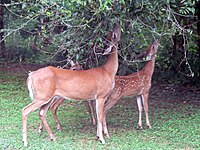
Photo from wikipedia
Ecosystem engineers alter environments by creating, modifying or destroying habitats. The indirect impacts of ecosystem engineering on trophic interactions should depend on the combination of the spatial distribution of engineered… Click to show full abstract
Ecosystem engineers alter environments by creating, modifying or destroying habitats. The indirect impacts of ecosystem engineering on trophic interactions should depend on the combination of the spatial distribution of engineered structures and the foraging behaviour of consumers that use these structures as refuges. In this study, we assessed the indirect effects of ecosystem engineering by a wood-boring beetle in a neotropical mangrove forest system. We identified herbivory patterns in a dwarf mangrove forest on the archipelago of Twin Cays, Belize. Past wood-boring activity impacted more than one-third of trees through the creation of tree holes that are now used, presumably as predation or thermal refuge, by the herbivorous mangrove tree crab Aratus pisonii. The presence of these refuges had a significant impact on plant-animal interactions; herbivory was more than fivefold higher on trees influenced by tree holes relative to those that were completely isolated from these refuges. Additionally, herbivory decreased exponentially with increasing distance from tree holes. We use individual-based simulation modelling to demonstrate that the creation of these herbivory patterns depends on a combination of the use of engineered tree holes for refuge by tree crabs, and the use of two behaviour patterns in this species-site fidelity to a "home tree," and more frequent foraging near their home tree. We demonstrate that understanding the spatial distribution of herbivory in this system depends on combining both the use of ecosystem engineering structures with individual behavioural patterns of herbivores.
Journal Title: Journal of Animal Ecology
Year Published: 2017
Link to full text (if available)
Share on Social Media: Sign Up to like & get
recommendations!